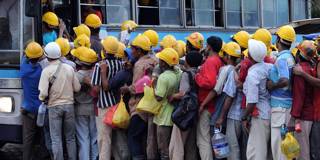As the experience of Malaysia and Bangladesh shows, the main beneficiaries of the region’s manpower-recruitment syndicates appear to be a handful of politicians, public officials, and business elites. Ensuring a competitive manpower industry is the best way to minimize migration costs and protect workers’ rights.
KUALA LUMPUR – COVID-19 has disrupted labor markets virtually everywhere, pushing millions of migrant workers into poverty. In high-income Asian countries, the pandemic has highlighted these workers’ vulnerability to redundancy, pay cuts, and exclusion from vital social safety nets. The authorities in Singapore and Malaysia have deported some of those who spoke out against inadequate provisions or mistreatment in the workplace.

KUALA LUMPUR – COVID-19 has disrupted labor markets virtually everywhere, pushing millions of migrant workers into poverty. In high-income Asian countries, the pandemic has highlighted these workers’ vulnerability to redundancy, pay cuts, and exclusion from vital social safety nets. The authorities in Singapore and Malaysia have deported some of those who spoke out against inadequate provisions or mistreatment in the workplace.